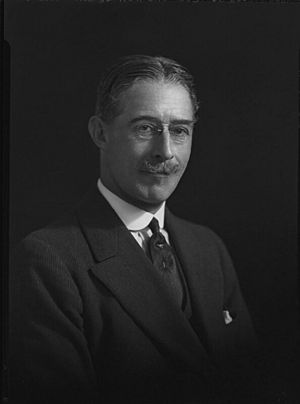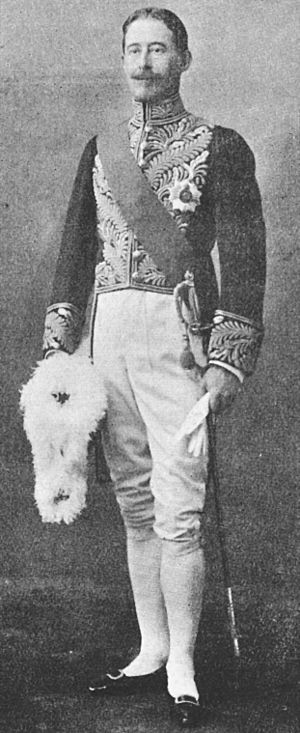Lawrence Dundas, 2nd Marquess of Zetland facts for kids
Quick facts for kids
The Most Honourable
The Marquess of Zetland
|
|
|---|---|
 |
|
| Secretary of State for India and Burma | |
| In office 28 May 1937 – 13 May 1940 |
|
| Monarch | George VI |
| Prime Minister | Neville Chamberlain |
| Preceded by | New office |
| Succeeded by | Leo Amery |
| Secretary of State for India | |
| In office 7 June 1935 – 28 May 1937 |
|
| Monarch | George V Edward VIII George VI |
| Prime Minister | Stanley Baldwin |
| Preceded by | Sir Samuel Hoare, Bt |
| Succeeded by | Office renamed Secretary of State for India and Burma |
| Governor of Bengal | |
| In office 26 March 1917 – 28 March 1922 |
|
| Governor General | The Viscount Chelmsford |
| Preceded by | The Lord Carmichael |
| Succeeded by | The Earl of Lytton |
| Member of the House of Lords Lord Temporal |
|
| In office 12 March 1929 – 6 February 1961 Hereditary Peerage |
|
| Preceded by | The 1st Marquess of Zetland |
| Succeeded by | The 3rd Marquess of Zetland |
| Member of Parliament for Hornsey |
|
| In office 5 June 1907 – 6 December 1916 |
|
| Preceded by | Charles Balfour |
| Succeeded by | Kennedy Jones |
| Personal details | |
| Born | 11 June 1876 |
| Died | 6 February 1961 (aged 84) |
| Nationality | British |
| Political party | Conservative |
| Spouse | Cicely Archdale (1886–1973) |
| Alma mater | Trinity College, Cambridge |
Lawrence John Lumley Dundas, 2nd Marquess of Zetland (born June 11, 1876 – died February 6, 1961) was an important British politician. He was known as Lord Dundas when he was younger, and later as Earl of Ronaldshay. He was a member of the Conservative Party. He knew a lot about British India and served as the Secretary of State for India in the late 1930s.
Contents
Early Life and Education
Lawrence Dundas was born in London in 1876. He was the oldest son of Lawrence Dundas, who was the 1st Marquess of Zetland. His mother was Lady Lilian Selena Elizabeth Lumley.
He went to Harrow School, which is a famous school. After that, he studied at Trinity College, Cambridge, a well-known university. While at Cambridge, he was part of a club called the University Pitt Club.
Political Career and Public Service

In 1900, Lawrence Dundas started working for Lord Curzon. Lord Curzon was the Viceroy of India, which was like the highest British official in India. While working in British India, Zetland traveled a lot around Asia. These travels helped him later when he wrote books.
He became a Member of Parliament for Hornsey in 1907. He held this position until 1916. A big part of his work focused on British India. In 1912, he joined a special group called the Royal Commission on the Public Services in India. This group looked at how public services worked in India.
Zetland served as the Governor of Bengal from 1917 to 1922. Bengal was a large and important region in India. Later, he became the Secretary of State for India from 1935 to 1940. This role meant he was in charge of British policy towards India from London.
Even though he was a Conservative, he believed that people in India should have more control over their own government. He thought India should eventually become a Dominion, like Canada or Australia. This meant it would be an independent country but still part of the British Empire.
Zetland played a key role in creating the Government of India Act 1935. This law aimed to give Indians more responsibility in governing their country. However, some powerful politicians, like Winston Churchill, were against giving India more self-rule.
Zetland was also an author. He wrote books about his experiences and ideas. He was the perfect person to put the new Government of India Act into action. However, the leaders in India, called Viceroys, were not always as hopeful as he was.
In 1937, the Congress Party won many elections in India. This surprised Zetland. His time as Secretary of State ended in 1940 when Winston Churchill became Prime Minister. Zetland felt his ideas about India were too different from Churchill's, so he resigned.
In March 1940, Zetland was shot at a place called Caxton Hall by an Indian nationalist named Udham Singh. Zetland was not seriously hurt; the bullet only bruised his ribs. He was able to attend the House of Lords a few days later.
Zetland was given many honors during his life. In 1922, he became a member of the Privy Council. In 1942, he was made a Knight of the Garter, which is a very high honor. He also carried the Sword of State at the coronation of King George VI in 1937.
He was the Lord Lieutenant of the North Riding of Yorkshire from 1945 to 1951. He also led important organizations like the Royal Geographical Society and the Royal Asiatic Society of Great Britain and Ireland. From 1932 to 1945, he was the chairman of the National Trust, which protects historic places and nature.
Family Life
Lord Zetland married Cicely Archdale on December 3, 1907. They lived in a place called Snelsmore in Berkshire. They had five children together:
- Lawrence Aldred Mervyn Dundas, who became the 3rd Marquess of Zetland.
- Lady Viola Mary Dundas.
- Lady Lavinia Margaret Dundas.
- Lady Jean Agatha Dundas.
- Lord Bruce Thomas Dundas, who was a Flight Sergeant in the Royal Air Force Volunteer Reserve and died in action during World War II.
Later Life and Death
Lord Zetland passed away in 1961 when he was 84 years old. His oldest son, Lawrence, took over his titles. His wife, the Marchioness of Zetland, died in 1973.


